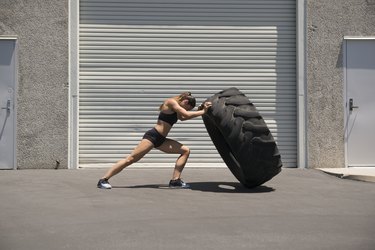
Resistance training is one of the fastest ways to get in shape, increasing lean muscle mass and improving bone mineral density. But early on, lifting weights can literally make you vomit.
A nausea response is most common in novice weight lifters, or in those who have not lifted weights for an extended period of time.
Video of the Day
Video of the Day
Tip
Lifting weights causes a hormonal response that can lead to feeling sick.
Nausea When Lifting Weights
Lifting weight invokes chemical changes in your muscles that can profoundly affect your blood chemistry. Lifting weights leads to an uptick in sympathetic nerve hormones, the same adrenaline-like compounds that are associated with the fight-or-flight response. This can lead to nausea when lifting weights.
Eliminating the contents of your stomach and bowels is a side effect of sympathetic excitation. Other factors that can invoke nausea include the failure to breathe properly, inadequate fuel stored in your muscle cells, and taking too short rest periods between sets.
Take a Deep Breath
Your muscles need oxygen to function and produce energy. The University of Delaware points out that if you don't breathe properly during resistance exercise, your muscles compete with your brain for oxygen. Lack of oxygen to your brain can lead to nausea and unconsciousness. When lifting weights, establish a rhythmic breathing pattern.
For example, inhale on the muscle shortening phase and exhale on the muscle lengthening phase. It doesn't matter if you forget which phase to inhale or exhale on. The important thing is that a steady flow of oxygen is available to supply your brain and muscles.
Fuel Up Ahead of Time
Another common source of nausea when lifting weights is inadequate fuel. During resistance training, you use a lot of glucose, stored in your muscles in the form of glycogen. Your brain also relies on glucose to function. If you do not have enough fuel stored in your muscles, or if you have not eaten in a while, your muscles compete with your brain for fuel.
According to the Mayo Clinic, lack of glucose delivery to the brain can lead to nausea and light-headedness or even unconsciousness. To prevent this, eat carbohydrates with your meal several hours before your workout and ingest a light snack 30 to 45 minutes before your resistance training session. A bowl of cereal with a sliced banana should do the trick. A restricted calorie, low-carb diet is not advised.
Easy Does It
Doing too much when you are just beginning an exercise program can lead to dramatic changes in body chemistry that bring on nausea. It will also inevitably lead to stiff, sore muscles. Rather than overdo it, ease gradually into your program for the first two to three weeks.
Gradually increase your weights, and the number of sets, reps and exercises to help avoid nausea when lifting heavy objects. After several weeks, your hormonal response will be less dramatic, and your body will have adapted to the chemical changes brought on by exercise.
Give It a Rest
Recovery is a very important component of resistance training, as discussed in an article in the March/April 2015 issue of the ACSM's Health & Fitness Journal. Recovery refers to both the amount of rest you take between sets and exercises, and the amount of rest you take between workout sessions. The recovery period between sets and exercises enables your body to restore its chemical balance, and to regenerate ATP for mechanical work.
Early on, allow one to two minutes for recovery before beginning your next set. The recovery period between workouts gives your muscle tissue time to heal, change and grow. Allow 48 to 72 hours between weight training sessions.